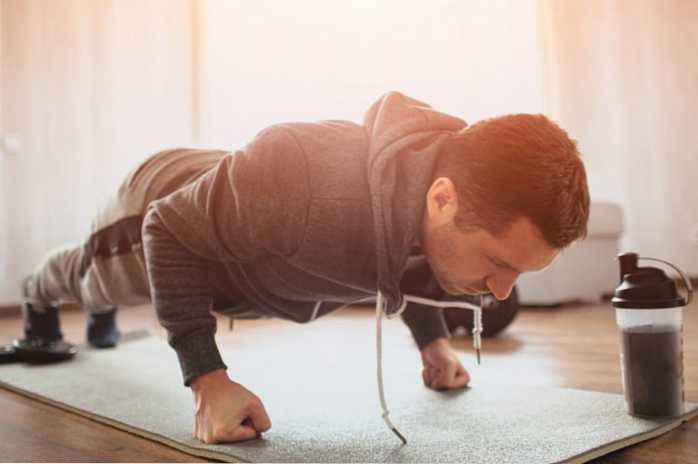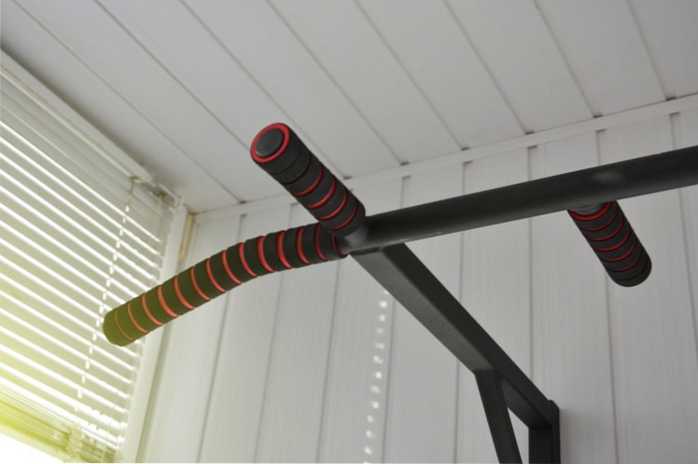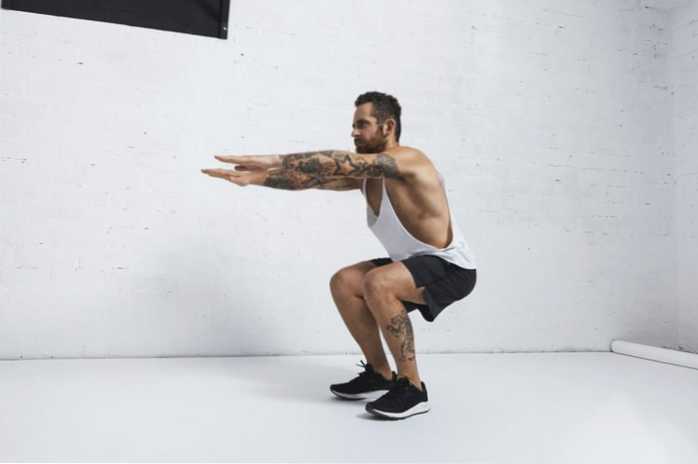
7 Tips For Maintaining Muscle Mass Without the Gym

If you heard “shelter in place” and immediately translated it into “no gym,” you're not alone.
Strength athletes of all kinds are trying to adapt to being socially distanced from lifting communities and the therapy (muscular and mental) that barbells offer. If you're finding yourself looking for motivation to workout without the gym, one of the questions that's probably at the top of your mind is whether you can maintain muscle without weights.
Redefining What “Gains” Are
For your own sanity, it's going to be important to accept that no - you can't make the same kinds of gains without equipment as you can with the training stimulus of a heavy barbell. To be honest? Your one-rep max might drop, and your muscle size might do the same. But that doesn't mean all hope is lost, and it doesn't mean that all your work has been for naught.
There are ways to maintain muscle mass without weights, and you can make all sorts of gains without the gym - you might just have to do the hard mental labor of adjusting what you define as “gains.”
Need to work on mobility? (If you're a strength athlete, the answer is almost certainly a resounding yes.) Make mobility gains! (They'll improve your lifts when you get back to your barbells, I promise).
Rarely do lateral or rotational movements because you're spending all your time in the sagittal plane with your big three? I feel you - now get your lateral lunges in. The increased stability will boost your squat and dead when you reunite with your lost iron lovers.
Does your cardiovascular capacity need some fine-tuning (you know it does)? Drop and give yourself all the burpees in the land. Because the more efficiently you can breathe, the more efficiently you can lift.
Sure, sure, you're saying, but what about muscle gains? Alright, I hear you. Let's get into it.
[Related: 5 Ways to Cope With Missing your Gym Buddy]

Can Bodyweight Exercises Maintain Muscle?
The short answer: yes. The long answer: if you do them with intention.
If your high volume squat days usually look like four sets of eight at 60-70% of your 1RM, then no, 50 or even 100 mindless bodyweight squats aren't going to be a good enough substitute for leg day. Volume is important, yes (and we'll spend some time on it below), but you also need to consider the differences between regular bodyweight training and heavy loading stimulus.
For maintaining muscle mass at home, you want to make sure you're getting in plenty of explosive, dynamic work - because so much of this is about your muscle fibers. You want to be able to continue recruiting the type II muscle fibers that get so much play when you're under heavy barbells. These fast-twitch fibers (which fatigue quickly but give you immensely powerful contractions) are what you use during powerlifting training, so they'll be priorities for you as you try to maintain or even build muscles without your gym.
Fortunately, you don't need fancy equipment to train your fast-twitch fibers - all you've gotta do is focus on moving explosively (and, in some cases… slowly). And because these bad boys are physically larger than type-I muscle fibers (which are recruited for endurance work like 5k runs and marathons), developing your fast-twitch muscles with bodyweight moves is going to help give you that pump you've been sorely missing.
So if you want to maintain muscle mass without equipment, the key is, honestly to get creative.
[Related: 3 supersets to help you maintain power without a gym]
How To Maintain Muscle Mass Without Weights
There are plenty of ways to do it, but depending on your specific goals (and your specific weaknesses that you should really spend this time working on), you might spend more time using some bodyweight strategies than others. It's going to be tempting to stick with what you like, but try to avoid that temptation - what you don't like is probably where your body needs the most work.
Hate tempo training? Spend just ten minutes on it a day, and use the rest of your workout time doing things you love. Your lifts will thank you when you get back to your platform.
Plyometric Work
Even (and perhaps especially) if you're accustomed to the slow grind of training powerlifts, now is the time to get some explosive work in. We're talking clapping pushups, jumping lunges, and yes, even burpees. You want to be recruiting those fast-twitch muscle fibers - which is hard without weights, unless you add some power - and explosive bodyweight movements will definitely do that.
If you're like me and live directly above someone else's apartment, all this jumping around can get a little… complicated. Even if it's directly in the middle of the day, I'm not trying to bang around on my neighbor's ceiling. Sometimes, that means I take it outside - find a hill nearby and run up it as fast you can. Hill sprints are a great way to develop muscles you probably didn't even know you had. And if parks are open near you, some grass stains might feel really good when you get your burpee on outside.
There are other ways to get in plyometric work when you live above your neighbor, though - you just have to get creative with your modifications. Do sets of 10 or 15 plyo pushups from your knees - you'll get a little less activation, sure, but by concentrating on controlling your descent (and therefore not slamming on your neighbor's ceiling), you're still getting plenty of bang for your proverbial buck. Try simulating jump rope movements as light as you can on the balls of your feet - your calves will light the heck up, and your neighbor won't want you to socially distance on Mars.

Volume
Sure, you want to amp up your explosive movement game, but you also need to keep your volume fairly high to compensate for the lack of gym time and movement as a whole. No, you don't have to do 500 bodyweight squats in a row (though if you want to, feel free to time yourself and try to beat your previous scores - just make sure your form stays pristine).
But since you'll be moving around a lot less in general than you probably would if you weren't practicing social distancing, you might want to use high-volume training as a way to both stimulate your muscles and make sure you're moving throughout the day.
Set a timer for an interval of your choice (10 minutes if you commit to this instead of checking Instagram, an hour if you know you're super intensely focused on a task). At that interval, bang out a solid set (10, 15, and 20 are all decent rep numbers, but pick your own poison) of lunges, pushups, bodyweight squats, or whatever else you're working on that day. Rinse and repeat every time your alarm goes off. Even when you're getting up to get more water (because you best believe you need to stay hydrated), try getting to the kitchen via walking lunges. Especially if you do this kind of thing as background movement to your actual, structured workouts, your volume will skyrocket and you'll be that much closer to maintaining muscle mass.

Single-Side Movement
Okay, powerlifters, it's your time to be honest. When was the last time you moved in the frontal plane (the one where you're moving from side to side)? What's that? Never? It's easy to forget about movements that aren't the big three when there are so many pretty barbells to work with, but now's your chance to develop lateral stability that will translate into much bigger lifts later.
Think multiple sets of 10 or 15 lateral lunges, lateral step-ups (just make sure whatever lucky surface you're using for this is super stable), and even archer pushups to get in some side-to-side upper body action. You'll be stimulating stabilizer muscles that too often get overlooked, and that will definitely help your body stay lifting-worthy.
[Related: 5 lateral movements every powerlifter should do]

Tempo
You might already do some tempo work in the gym, and that's awesome. But now that you're working out gym-less, spending some time in slow, grinding, perfect-form tempo pushups might be a whole new (and amazing) experience. Two slow seconds (one chimpanzee; two chimpanzee - full words, no rushing) down, two slow seconds at the bottom, two slow seconds coming back up, two slow seconds in plank position at the top… and over again. Take that formula and apply it to sets to near failure of squats, lunges, chair dips, and the inverted rows you can totally do by rigging up spare bedsheets and a stable door, and your muscles will be golden.
Tempo work, by the way, is also a great way to train your brain. You'll want to rush through the reps, and you'll want to quit. Obviously, if you're in pain or need a break, always take care of your body first. But otherwise? Just… keep going. Commit yourself to counting slow, to moving slowly, and you'll likely find that your mind will be much calmer when you get stuck in the hole at the bottom of a squat or clean. That calmness, that sense of I know what this strain feels like and I can get through it will serve you very, very well when you get back to the gym.
[Related: How tempo work helped me push through a plateau in the gym]

1.5 Reps
These hurt so good, and with excellent reason - you'll get to move through a solid range of motion (a Bulgarian split squat to depth, for example), and then you'll… stop. One solid, full rep, then a half rep (coming halfway up the split squat, for example), back down (to the hole), and get back up again (to standing with your rear foot elevated on a chair).
It's not cute. It certainly won't feel cute (though it should look cute, because your form will need to be pristine - since you don't have weights, this is a perfect time to cultivate perfect form). But doing 3-4 sets of 10-15 1.5 reps per movement will train your muscles to push themselves beyond when they think they're going to get rest, which is exactly the kind of new and difficult training stimulus you want to maintain muscle mass with just your bodyweight.
Backpacks And Bed Sheets
You might not have the iron you're craving, but you probably have more weightlifting equipment in your home than you think you do. Got a spare couple of bedsheets? Tie a big knot at the end of both of them and drape the knots over your door (make sure your door is solid). Close said door. Check again for solid-ness. If everything feels stable, who needs TRX bands? You've got… bedsheet… bands? The point is, you can now work wonders on your body with sets to near failure of assisted pistol squats and inverted rows - and those are definitely excellent muscle-maintaining bodyweight moves.
Don't have the bedsheets to spare? You've probably got books and a backpack lying around somewhere. Load the backpack with some Harry Potter tomes, and suddenly you can do weighted pushups, front squats (because you can totally wear your backpack on your chest), weighted pistol squats, Bulgarian split squats with your rear foot elevated on a chair (it's gonna hurt, but it's gonna be good)… you name it, you can do it. Sure, it won't be the same as a barbell, but it'll add resistance to your bodyweight movements and won't cost you a thing.
[Related: 4 household items that double as lifting equipment]

Boxing
Yeah, you might turn to boxing or kickboxing for some much-needed variety (not to mention cardio), but don't overlook the power of throwing some solid punches for your musculature. Specifically, if you're worried about training your back without weights or a pullup bar, getting in some boxing is going to be a massive help.
Your lats get a lot of work when you throw punches, especially crosses and hooks. You're going to recruit your lats in a similar way to how you recruit them in a bench press - they're going to help you bring your arms back to your body. But because you're snapping hard and fast punches with tight form, that recoil is going to give your lats the unexpected, equipment-free back workout you've been sorely missing. And the pun is intended, because if you're not used to boxing, after a half-hour of boxing combos, you will be sore.

Nutrition for Maintaining Muscle
Of course, you're probably going to be even more drawn to comfort foods now than you are when you have more freedom to get up and go about your regular routine. That's totally normal, and remember that you're taking care of your mind and your body. So if you're digging into that chocolate stash you squirreled away, more power to you. But remember that nutrition is extremely important when it comes to your gains, so you probably want to keep that in mind as you think about maintaining your muscle mass.
Don't Give Up On Protein
It might be tempting to throw up your hands and say “who needs protein anymore, my muscles are going to wither away anyway.” Firstly, try not to despair. As we discussed above, your muscles are going to be just fine. If you want to keep them that way, though, you still have to feed them. That means protein. Try sticking to your regularly-scheduled lean protein intake, especially if you're working your muscles to failure during the above workouts and movement patterns. Experts suggest at least 0.7 grams of protein per pound of bodyweight every day.

Adjust Your Carb and Calorie Intake As Desired
A lot of lifters I know are actually getting in a lot more cardio than they did when they had access to barbells. To maintain muscle mass, of course, things like hill sprints and strength-oriented cardio (think kickboxing and AMRAP work) are going to be important. But still… you may well find that you're getting in more cardio than you usually do. So, you might find that your body can maintain its regularly-scheduled carb and calorie intake just fine.
Be mindful, though (and super honest with yourself), about the amount of general moving that you're not getting in, simply based on the fact that you're not commuting, venturing outside, and roaming around the office to annoy your colleagues throughout the day. Given that, you may well want to reduce your usual calorie and carb intake to compensate for reduced movement so that you can maintain quality muscle. Prioritize carbs around your main workout itself, just like you would do during not-quarantine.
Stay Hydrated
Your muscles need water just as much as the rest of you. You might think it'll be easier to maintain your hydration habits during quarantine, but it can actually be even harder to lose track of whether you're drinking enough water when you're at home. If you typically hydrate using a water bottle (to remind you to drink, and to keep track of how much you're drinking), keep that habit up - lug your water bottle around the house with you and make sure you're giving your muscles the drinks they need to stay strong.
Go Forth And Maintain Your Mass
Even with all the creative ideas in the world to help you maintain your muscle mass with just bodyweight training, it's going to be normal to lose some of the specific strength gains you can make under a heavy barbell. But if you spend this time focusing on your weaknesses and getting smart about your training, you'll get those gains back super quickly - and, because your body will probably be moving much more effectively after building your kinesthetic awareness with all this bodyweight work, your lifts will probably look and feel a lot cleaner, too.
It's okay to get down about not being able to get to your gym. It's normal to want to throw up your hands and never get off the couch again. But you're not alone in all this, and you won't wither away - scout's honor. You've got this, and your muscles (and you) will get through it just fine.
Featured image via thedesailifestyle on Instagram.



Nimeni nu a comentat acest articol încă.